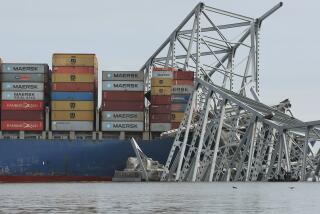Tech Offers Safer World, but at a Cost
- Share via
Herbert Lin, a senior scientist with the National Research Council, offers a chilling calculation. He estimates the twin impacts of aircraft on the World Trade Center released about a kiloton of energy combined--or the equivalent of a tactical nuclear weapon.
“Of course, a nuclear explosion would release all that energy in a microsecond, and this energy was released over several seconds, so they’re very different,” he said. “But it’s sobering.”
And it leads to a host of questions about how technology can protect us from horrible accidents or insane acts. For starters, how to engineer buildings that can withstand the sort of force that toppled the twin towers?
The technology exists to do it today, according to experts at the Protective Design Center, run by the Army Corps of Engineers. But just because an office building can be designed to withstand a nuclear blast doesn’t mean it’s the kind of place you or I would want to work.
That’s the delicate paradox of technology. The last decade has sparked an almost religious belief in the healing power of tech. It energized the economy, democratized mass communication and gave everyone who could afford it a wider view of the world than during any time in history.
Just below this patina of wonder, though, lies the power to track a person’s keystrokes at work, to monitor what that person reads at home and to compile what he or she buys at the mall. The same technology that improves safety also can impinge on liberty.
Which gets us back to safer buildings.
The Protective Design Center, headquartered in Omaha, develops building techniques to protect troops deployed around the world. As a result, the engineers there have developed expertise in putting together incredibly safe structures.
“We’ve designed facilities that can withstand a nuclear attack,” said Dan Sommer, the center’s chief. These days, the two dozen engineers in the office spend their days blowing up stuff and taking the information gleaned from those experiments to design even safer structures.
It’s a sure bet that many of those recommendations will be adopted by the civilian sector. But moving everybody into bunkers is unacceptable for a country like the United States. Sure, it’s safe--in the same way an armored personnel carrier is safe. Most people don’t drive around in armored personnel carriers, though.
They do, however, drive around in cars with air bags and shatterproof windows. And minor tweaks like that can make a big difference in buildings. When a bomb goes off, Sommer said, “glass from windows causes 90% of injuries.”
The glass on car windshields won’t shatter and fly off in jagged pieces. That’s because windshields have a layer of plastic inside. This laminated glass is required by law in windshields. New Defense Department facilities will have laminated glass in the windows. Sommer said using concrete masonry block is sturdier than steel stud walls for the underlying structure of a building.
These are the sort of minimal changes that can offer much greater protection for just a little bit more money.
“The average cost increase is 1% to 3%” over traditional methods, Sommer said.
Sommer and his co-workers have lots of tricks to minimize the amount of reinforcing needed for a site. For instance, new Defense Department construction doesn’t have parking lots close to buildings. Folks might have to walk in the rain sometimes, but at the same time, the farther away a car bomb is from a building, the less damage it’s going to do when it goes off.
None of the techniques developed by the center is a panacea, however.
No one knows, for instance, how to protect against the kind of airborne threat that destroyed the World Trade Center without fundamentally altering the nature of American society. Engineers could turn the White House into an impregnable fortress, but bomb shelters aren’t very pretty. Heck, airplanes could be equipped with remote-control systems so that if they went off course, traffic controllers could guide them to a safe landing. Or pitch them in the ocean. But that’s not how things are done in this country. At least not yet.
And, hopefully, it never will be. The truth is there’s no magic technological wand that could make the World Trade Center--or any modern building--completely safe. Engineers don’t believe it’s possible to put up a skyscraper absolutely resistant to attack.
But acknowledging such risks and creating these monumental works of art anyway is an affirmation of American values, a challenge to those who oppose them and an inspiration to all those everywhere who suffer under an oppressive regime.
It’s probably a good idea to use safer glass in buildings. But buildings without windows will block more than sunlight.
*
Dave Wilson is The Times’ personal technology columnist.






